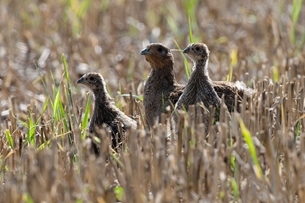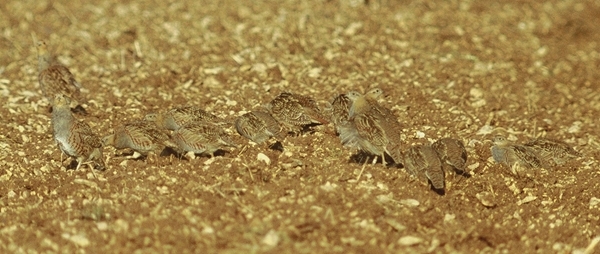By Francis Buner, Senior Conservation Scientist
 |
A grey partridge hen with two three-week-old chicks. If
encountered in early September, this would be a very
late brood where the cock has been lost to predation.
By early winter, this hen with her young would almost
certainly either join a larger covey, or they would be
joined by barren birds. (Photo credit: Markus Jenny) |
The beginning of September is a busy period at Rotherfield and many other grey partridge areas across the UK. It is the moment of truth for hundreds of partridge enthusiasts such as wild partridge keepers, landowners and farmers, birdwatchers and conservationists.
They all take to their binoculars to count ‘their’ autumn stock of one of the fastest-declining farmland birds. This population count allows them to assess how good or bad the breeding season has been for the grey partridge and other gamebirds.
Monitoring breeding success forms an integral part of any serious wildlife recovery programme because this is the only way to document progress in an objective way.
It is also by far the best way to allow informed decisions to be made on how and when to adjust a recovery project if things don’t go as planned (in the case of the grey partridge, this is more often the case than not).
However, to collect the information correctly, some basic partridge ecological knowledge and good ID skills are necessary, as counting the number of young per covey (family group) does pose a few challenges, even for the best birders. First, it is important to know that barren pairs (pairs that failed to fledge own young) can do one of three different things come early September:
- 1) They can remain together as a barren pair.
- 2) They can join up with other barren pairs, single cocks or hens and merge into groups/coveys of barren adults. In this case the covey does not contain any young birds.
- 3) They can join a pair which has fledged their own young. In this case the covey will typically contain both adult parent birds with their young plus an additional number of adults, normally 1-4 more.
In the latter case, a barren cock might join a family group and hence the covey will consist of two adult cocks, one adult hen and her young. However, a variety of options are possible including 2-3 adult cocks leading some young, where the female has been predated post-hatching and 1-2 barren cocks (who have lost their female during the incubation period) have joined the single cock with his young.
To make things even more complicated – or interesting, depending on the way one may look at it – even a fourth option is also possible:
- 4) A pair that has produced only a very small brood (1-2 juveniles, maybe even up to three), join another pair with their own young to form a ‘super-covey’.
In the above case, the young of the two broods are normally of the same age, and hence it is impossible to tell whether the covey one is looking at consists of two broods or just one, joined by a barren pair.

Grey partridge pair with 12 approx. 9-week-old young, a typical scene during an early September
stubble count. The two adults are on the far left (the cock slightly out of focus behind the hen, which
seems to be leading the young). (Photo credit: Francis Buner)
In order to assess the number of young per pair correctly (information that is needed if one wishes to calculate the number of hens that have successfully produced a brood of young within a project area), it is important to document the number of adults against the number of young.
By now I am guessing that you get the idea of how complicated the supposedly simple task of counting grey partridges is.
Unfortunately, things get even more complicated because, depending on the juvenile’s age at time of counting, they can look remarkably similar to adults. Making things worse, adult males in worn autumn plumage can be confused with adult females.
To help you master these field ID challenges, the GWCT has created a new grey partridge ID guide for bird ringers and field observers. Please feel free to download our new factsheet here to help you improve the accuracy of your autumn counts.

Grey partridge stubble count in early September. Please join the GWCT’s Partridge Count Scheme
to help monitor and conserve this iconic farmland bird on your land. (Photo credit: Francis Buner)
Over 1,000 farmers, gamekeepers, landowners and managers are currently registered in our Partridge Count Scheme (PCS), with between 600 and 800 taking up the challenge to do partridge counts each spring and autumn. There are no restrictions on how many partridges you need to have, nor do you have to be interested in them as a quarry species. When it comes to grey partridges – every one counts and the new ID guide should help to do this more accurately!
The PCS is a free and voluntary scheme that has been running since 1933. It provides invaluable data to the GWCT to help understand what’s happening to our wild grey partridges, locally and nationally, year on year – for 83 years and counting! All from a few hours of effort put in by PCS members twice a year.
In return, based on these counts, the PCS provides its members with site-specific results to help them better understand what happening on their ground, what management or habitats may not be working so well, and information on how to improve their partridge numbers. Members get invitations to farm visits and Advisory Service talks through our Partridge Group network.
We hope that many more farms and shoots, whether you have 3 or 30 pairs, will want to get involved and provide the grey partridge with a more secure future. The future of the grey partridge rests in the hands of individuals on the ground through the management measures they put in place, but the PCS can help. If you would like to be part of the Partridge Count Scheme and the future of grey partridges, go to www.gwct.org.uk/pcs.
Please support the Rotherfield Restoration Project